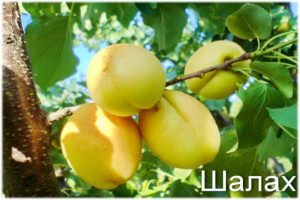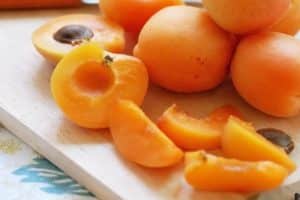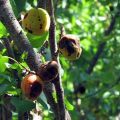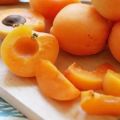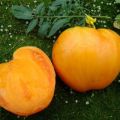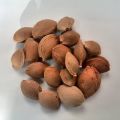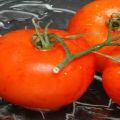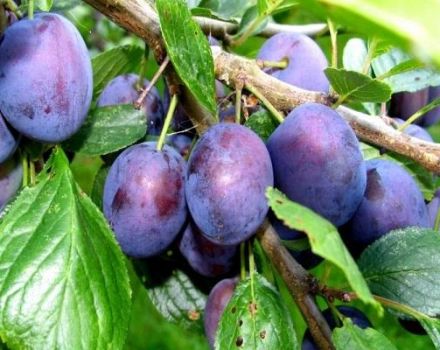Characteristics of the honey apricot variety, description of yield, planting and care
Until today, Honey Apricot has not been included in the State Register of Fruit Trees of the Russian Federation, despite the fact that it was bred at the State Scientific Institution on the basis of frost-resistant varieties obtained there. The fact that the plant was not officially recognized did not affect its popularity among amateur gardeners. It is one of the few apricot varieties that can easily endure severe winters.
Breeding history of the variety
In 1996, breeder Kabir Kadirovich Mullayanov, an employee of the South Ural Research Institute of Fruit and Vegetable and Potato Growing, presented the gardeners of the Urals and central Russia with the opportunity to grow apricots on their plots. Experiments to improve the previously bred Kichiginsky variety have lasted since 1990, they were carried out on the basis of the Chelyabinsk State Oil University. With free cross-pollination, the original varietal seedling received new characteristics. And so a new variety came about.
Description of the variety of frost-resistant apricot
A mature tree reaches a height of 5 meters. The crown (4 m in diameter) is spreading with medium-sized dark green teardrop-shaped leaves, decorated with a fringe of small notches at the edges. The gray-brown hard bark with signs of cracks running along the trunk is a varietal trait of a cultivated plant with dry, rough bark.
During flowering, the tree is strewn with white and slightly pinkish single flowers.
Medovy does not differ in large yields; about 20 kg can be removed from one tree per season. The variety has:
- high winter hardiness;
- early fruiting;
- stable yield;
- unpretentiousness to the climatic features of the growing region;
- minimum care;
- immunity to fungal and infectious diseases.

A description of the apricot variety would not be complete without mentioning its fruits, which are larger in size than medium-sized plums. Ripe fruits contain vitamins, minerals, tannins, malic, citric and tartaric acids.
Characteristics of the fruits of the table variety of apricots Honey:
- weight - 15 g;
- elastic, medium-thick skin with a slight edge;
- color - from bright yellow to light orange;
- bright yellow flesh has a grainy-fibrous structure.
Fruit tasting score - 4.3 on a 5-point scale. The fruits of the Honey Apricot are suitable for canning.
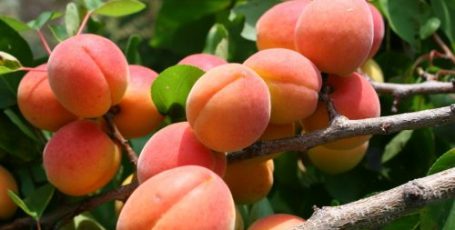
Advantages and disadvantages
Medovoy has only two drawbacks - the height of the tree, which complicates the care of the crown and the collection of fruits from the branches in the upper part of the crown; for the formation of an ovary, the tree needs natural cross-pollination with another (self-sufficient) apricot variety.
There are much more positive aspects when growing a winter-hardy variety of apricots in a temperate climate:
- the fruit tree gives the first harvest 3-4 years after planting;
- 15-20 kg of apricots every year;
- easily tolerates frosts down to -40 ° C;
- good regeneration after frostbite;
- fruits are stored for a long time, without losing either taste or presentation;
- resistant to damage during transportation.
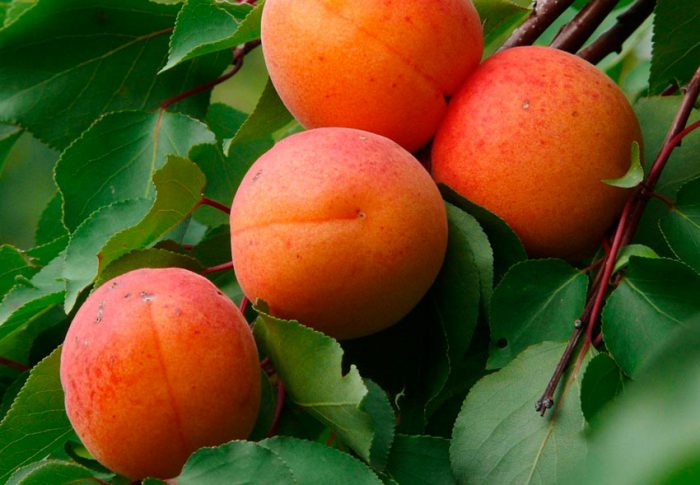
For your information: the Kichiginsky variety is often used as a pollinator.
Pollinator tree characteristics
The frost-resistant variety Kichiginsky, became the progenitor of Honey and is a necessary addition to the garden for its fruiting. Not all the best features of this variety were passed on to his descendant Medovoy.
General characteristics:
- even symmetrical fruits;
- tree height from 3.5 to 5 meters in height;
- the skin and bone are easily separated from the pulp;
- the yield is stable (about 15 kg);
- the variety is self-fertile.

The differences lie in the absence of excessive branching of the crown and a later period of fruit ripening.
Attention! Kichiginsky serves as a pollinator for many varieties of apricots of the Ural selection.
Features of planting and care
The younger the seedling, the faster it adapts to new conditions - soil features, air temperature. Experienced gardeners recommend taking a one-year-old. A seedling grown from a seed will tolerate adaptation even better. Before planting a young plant with an open root system, its growth can be stimulated with "Kornevin", "Epin", "Heteroauxin". The root system is soaked in one of these solutions for 12-24 hours.
When planting several trees, the distance between adjacent seedlings should be 3 m, and between rows 5 meters. Planting is best done in early spring, and holes for seedlings should be prepared in the fall. Each of them is 80 cm3... At the bottom of the pit, a 20-cm layer of drainage is laid out - crushed stone, broken brick, coarse-grained pebbles or gravel.

The soil selected from the pit is enriched with ash, peat, humus, ash and superphosphate fertilizer, after which it returns to the pit with a beacon pre-installed in it - a stake towering above the surface. The roots should not be in direct contact with the mineral-rich layer, but should be separated by a pillow from ordinary garden soil.
Planting depth depends on the length of the root system. The root collar is not buried; it should be on the surface. A moat is made around the seedling, like a drainage one. It is needed to distribute water directly within the radius of the root system. After abundant watering, the tree needs to be tied to the vertical guide.
Pruning apricot
Old branches of the tree are pruned once every 5 years. But pruning is also necessary for the formation of the crown. The first time pruning is done immediately after planting the seedling, it is shortened to 70-80 cm. This contributes to the formation of skeletal branches of the plant. By the middle of summer, they will grow about 70 cm, they need to be pinched, which will be a signal for the formation of branches of the next level.

Incorrectly growing branches must be cut off. These include those whose angle relative to the trunk is less than 50 °. Shoots will appear from the stambic at the cut site. Only one of them should be left, the strongest. Fruit-bearing spurs form on branches that are 2-3 years old. Branches that have ceased to bear fruit are removed at the stage of a planned 5-year pruning.
Diseases and pests
Cytosporosis. Despite the high immunity to fungal infections, Honey Apricot can infect this type of fungus. Cytosporosis is manifested by bumps on the bark. You can prevent it from spreading if you delete old branches in time.The probability is small, but nevertheless, bacterial necrosis, like any cancerous tumor, can destroy a winter-hardy apricot variety. At an early stage, it manifests itself as burn spots on the bark. A little later, ulcers form, from which gum oozes.
The disease affects all tissues of the tree, it gradually dies. If the first signs of the disease appear on the branches, and not on the trunk, then the tree can be saved.
Monilial burn is a consequence of exposure to cold and moisture on the shoot during flowering. Some of the branches die, the blossoming leaves turn brown and dry out. If the ovaries appear on the plant, then the consequences of the defeat can manifest themselves during fruiting in the form of rot on the fruits.
Pests of plums and apricots are the same - aphids, moths, leafworms. This is the main reason for planting these fruit trees as far apart as possible. When planting apricot Honey, you no longer need to be afraid of infectious diseases or fungi, but insects.
